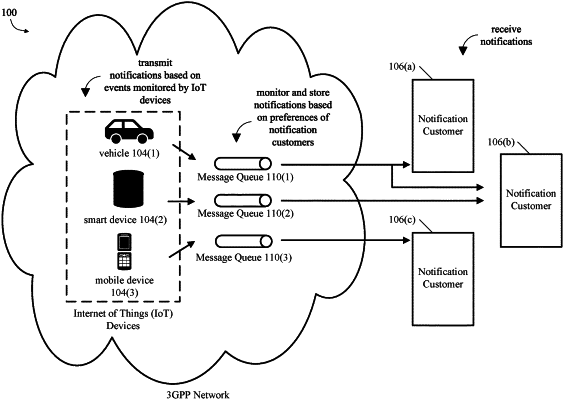| CPC G06F 9/546 (2013.01) [G06F 9/542 (2013.01)] | 20 Claims |

|
1. A system comprising:
a processor; and
computer-readable instructions that, when executed by the processor, cause the system to perform operations including:
receiving, from notification customers, customer preferences for routing a selection of notifications associated with Internet-of-Things (IoT) devices, the customer preferences including a first customer preference, a second customer preference, a third customer preference, and a fourth customer preference, the first customer preference received from a first notification customer of the notification customers, the second customer preference received from a second notification customer of the notification customers, the third customer preference received from a third notification customer of the notification customers, the fourth customer preference received from a fourth notification customer of the notification customers;
utilizing the first customer preference to configure a first message queue to have a notification type configuration option satisfying a notification type parameter, no preferences of the second notification customer, the third notification customer, or the fourth notification customer being received for the notification type configuration option of the first message queue;
utilizing the second customer preference to configure a second message queue to have a notification priority configuration option satisfying a notification priority parameter, no preferences of the first notification customer, the third notification customer, or the fourth notification customer being received for the notification priority configuration option of the second message queue;
utilizing the third customer preference to configure a third message queue to have a IoT device location configuration option satisfying an IoT device location parameter, no preferences of the first notification customer, the second notification customer, or the fourth notification customer being received for the IoT device location configuration option of the third message queue;
utilizing the fourth customer preference that to configure a fourth message queue to have an IoT device type configuration option satisfying an IoT device type parameter, no preferences of the first notification customer, the second notification customer, or the third notification customer being received for the IoT device type configuration option of the fourth message queue;
receiving first notifications with a first received parameter that includes the notification type parameter or the notification priority parameter;
receiving second notifications with a second received parameter that includes the IoT device location parameter or the IoT device type parameter;
utilizing the notification type configuration option or the notification priority configuration option to perform a first message queue selection;
utilizing the IoT device location configuration option or the IoT device type configuration option to perform a second message queue selection;
storing the first notifications in the first message queue or the second message queue satisfying the first received parameter based on the first message queue selection;
storing the second notifications in the third message queue or the fourth message queue satisfying the second received parameter based on the second message queue selection; and
transmitting the selection of notifications, the selection of notifications comprising at least one of i) the first notifications being transmitted from the first message queue or the second message queue, and, respectively, to the first notification customer or the second notification customer, or ii) the second notifications being transmitted from the second message queue or the third message queue, and, respectively, to the third notification customer or the fourth notification customer.
|